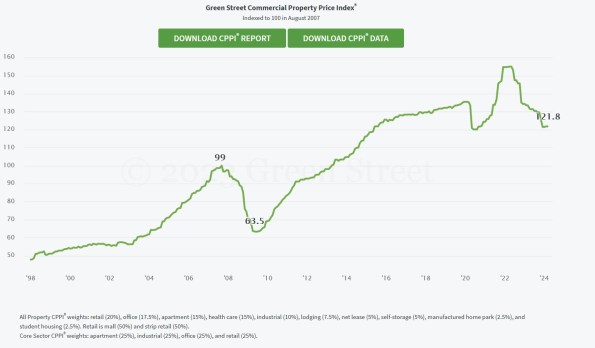Four fairly quick observations on this Federal Reserve meeting day, not all of which have anything to do with the Fed:
1. The FOMC today announced unchanged policy for now on the overnight interest rate, on the pace of QT runoff, and on the collective expectation of the Committee for the number of rate-cuts in 2024 (three, 25bp cuts). But it beats noting that while three cuts is the median expectation, the mean expectation dropped substantially. Only one official sees four rate cuts in 2024, compared to five who saw that many or more, as of the December survey. Those four folks moved to ‘three’, and one of the ‘three’ folks moved to ‘just one.’ Nine of the nineteen dots are for fewer than three cuts this year, so we should say this is a closer call than the market seems to think.
2. The longer dot plots also show some increase in Committee members’ expectations for the neutral short-term interest rate (the so-called ‘r-star’ originally popularized, I think, by Greenspan). The significance of this for investors and traders is that the overnight rate is unlikely to go back to zero unless we get another enormous calamity; the significance for the economy is essentially nil since it is money, and not interest rates, that matter. I’ve written before about why there are good reasons to think of something like 2-2.25% as the neutral long-run real rate, and so if CPI inflation is expected to be 2.25%-2.5% then something around 4.5% is neutral long-run nominal rate. We are mighty close to that now, so there is no compelling reason to think that interest rates should decline markedly from here. At the short end of the curve, we should eventually be lower – but we need to also keep in mind the growing imbalance in the supply and demand for Treasury paper, which (in the absence of recession) will tend to keep rates on government paper higher than they otherwise would be in equilibrium – and as one consequence, by the way, credit spreads will tend to be lower than they otherwise would be for a given level of creditworthiness.
3. The Fed clearly believes that the situation in Commercial Real Estate (CRE) and its effect on the banking sector is manageable. If they didn’t think so, then they would be hastening to lower rates to ease the refinancing problems that are hitting that sector. I have been reading alarmist analyses saying that the $1 trillion in CRE mortgage maturities due this year will lead to ‘hundreds’ of bank failures. This falls into the Big Number is Bad and Scary school of analysis. One trillion is a lot of mortgages and that will cripple banking! Except…
Let’s suppose that 20% of those mortgages go into default – a number more massive than we’ve ever seen before – and that recovery is 80%. For reference, in the 2008-09 crisis CRE values fell by about 36% according to the Greenstreet Commercial Property Price Index (chart below), and that was against a backdrop of 1%ish inflation. The nominal price decline should be less in an environment where underlying inflation is 4% per year, naturally. Since the CRE peak, real values have fallen 31% but nominal values only about 21% on the basis of that index. But the drop from the peak isn’t the relevant part. Even the shorter loans now coming due were struck 3-5 years ago, and the drop from that level is only about 9%. Plus, the initial loan-to-value levels were not 100%. So (and all of this is just to cuff a rough estimate) a 20% loss when selling out the collateral on a defaulted mortgage seems conservative.
Those numbers mean the $1T in mortgage maturities could produce a loss of $40bln (1,000 * 0.2 * 0.2). That’s still a big number, but remember that it is spread over a lot of banks. Suppose that it is spread over only 2,000 banks, and that the losses have nothing to do with bank size. Then you are looking at losses per bank of $20mm. That’s bad for a small bank, but the losses at a small bank will of course be smaller because they have smaller books. Will that sink ‘hundreds of banks’? Only if they are small, fairly insignificant banks.
Will some banks fail because they lent too much against commercial real estate which has fallen in value, at too-high loan-to-value ratios, and end up owning property that they can’t sell? Almost certainly. But after negotiations and forbearances and the eventual foreclosures – in an environment where the price level is rising 4% per year – I just don’t think this is something we should worry about. To be fair, the fact that the Fed is not worried about it is something that makes me worry about it.
4. I have been befuddled recently because airfare prices in the CPI have been higher than would be anticipated given the movement in jet fuel prices. Belatedly, I think I know what is going on. The issues with Boeing (NYSE:BA) planes has meant that (and I didn’t know this) Boeing has greatly reduced its deliveries to airline companies as they sort out the problems with their Max jets. I became aware of this only recently when a Bloomberg story highlighted how Southwest Airlines (NYSE:LUV) is cutting capacity and freezing hiring because they aren’t getting the planes they need. Steady demand and constraints on supply means higher airfares, as I also discovered this week when I was booking a flight to Chicago. Yikes! With jet fuel prices also rising again, this is something to factor into CPI forecasts going forward. It’s surely ‘transitory,’ but it takes a long time to build a plane and in the near-term this is more likely to be solved on the demand side if we have a recession, than on the supply side with a sudden influx of planes.

